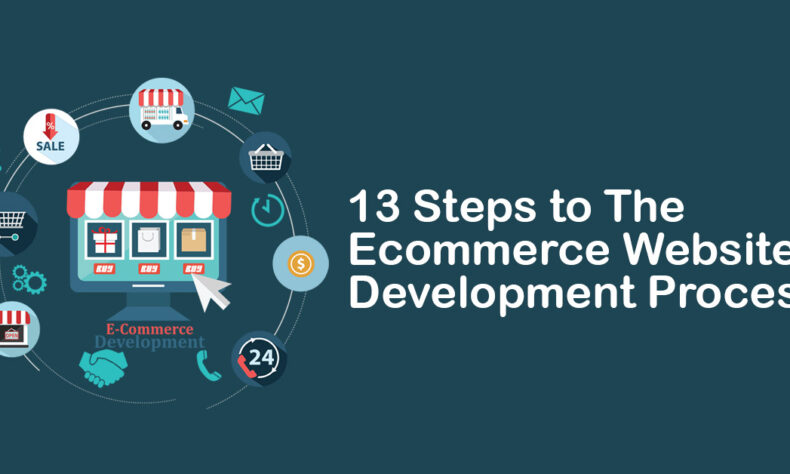
We’ll guide you through the eCommerce website design process, from branding to shipping e-commerce website development.
According to Nasdaq, 95% of all purchases will be made through eCommerce by 2040. We have outlined a 13-step process to help you build a successful eCommerce shop in no time.
The eCommerce website development process: the 13 steps
This is a simplified version of the 13 steps we have provided that will help you simplify your eCommerce website development and get you to your business goals.
1. Determine what you want to sell.
A business that revolves around your passions can be a fun one to run. Finding your niche is easy, no matter what it may be, whether you are into high-end watches or boutique guitar effects pedals.
Many businesses were started for other reasons. Perhaps you recognize a market need and want to provide solutions for potential customers.
No matter what your business goals are, you need to do research on the products and people you want to sell them to. This is crucial if you want to be successful and not end up with too much merchandise.
Know your market. Know the market and what products are selling well. Also, be aware of trends and new products. Being an eCommerce site owner means knowing not only what your potential customers need now but also what they will want in the future.
There’s also the competition. It will be difficult to gain any kind of success in a market dominated by large players with huge marketing budgets. You can have a better chance of succeeding in a niche that has more room. You can win by entering a niche with a unique approach, unique branding, or a better user experience than the competition.
2. Determine your eCommerce business model.
Several types of eCommerce business models exist, but the two main categories are business-to-business (B2B) and business-to-consumer (B2C). It is crucial to know the difference and where your eCommerce business falls within it.
B2C (business-to-consumer)
We interact most often with online retailers through our business-to-consumer (B2C) channel. We have completed transactions on B2C websites, regardless of whether it is Amazon, Zappos, or Target. B2C websites sell items and services directly from businesses to the public without any intermediaries.
B2B (business-to-business)
As the name implies, business-to-business (or business-to-business) is a type of business that sells to other businesses. These companies might be manufacturers, wholesalers, or providers of services and products in a particular industry. Room is a great example of a B2B eCommerce business.
3. Know your audience.
You can start an online business in an area that you are familiar with. This is because you know your audience and have been there. Even if you know your customers well, it is still beneficial to do some research on them in order to improve your eCommerce business.
Every step of the eCommerce development process is affected by understanding your potential customers. Every aspect of eCommerce development must be customized to meet the needs of your customers. This includes the user interface and user experience, as well as the visuals and content.
It is important to know all the details of your potential customers. allow you to create an eCommerce site that is tailored to their needs and tastes, thereby creating a stronger relationship with them and a better user experience.
4. Choose a good business name.
Avoid falling for clichés and naming your business something too similar to others. Your business must be different. Unique names will make you stand out from others in the same market.
It should be succinct.
Business names that are concise make for better business names. Are there any eCommerce websites or storefronts that are more than one or two words long? Let’s take a moment. We didn’t believe it. We think short names are better for brand recognition. Just ask Apple, Etsy, or Google. People want simple names that are easy to remember, and not complicated.
Be unique
A boring, generic name can degrade a brand’s image, regardless of how good its products and services are.
Mailchimp, Blue Apron, or the grocery store Sprouts are just a few examples. Names that are distinctive and different from others in their domains will make them stand out. Your e-commerce website should be unique and memorable.
And let’s not forget being able to snag a domain name. A unique brand name means you have a better shot at getting your ideal domain name. If your desired domain name is already taken, with a little creativity and wordplay, you might be able to come up with something close.
While.com is the most popular top-level domain, there are many other options available if you don’t find one. There may be something in.biz or.shop.
5. Buy a domain name.
You have now chosen a business name. Register the domain name before you start building the store. You never know what the internet might bring you, so register your domain name now. Purchase your domain name now so you don’t have to worry about it later. We are here to help.
6. Determine your branding.
Coca-Cola and Starbucks are deeply ingrained in our collective consciousness. These brands are more connected to their customers than those whose identities are less clear. Businesses are transformed from anonymous entities to ones we feel connected to through branding. It is what creates brand loyalty.
A website that sells eCommerce products must have a distinctive voice, a unique logo, and a color palette. These elements are all combined into a user experience that is driven by the brand’s character.
Branding is not complete without telling your story. Your customers should understand why you have an eCommerce website and who the people behind it are. If you don’t humanize your brand, it will be just another digital portal. Many people are reluctant to give their credit card numbers to an anonymous website that doesn’t provide any product information. Trust is built by personalizing your brand.
Your brand needs to have a voice. Voice transforms dull monologues into engaging and active writing. Your brand’s voice is what will make it stand out from the rest. Consider Gillette versus Dollar Shave Club, Purple Mattress, or Tuft & Needle. Your brand’s voice is a way to make your brand easily identifiable. Your brand voice will influence everything, from your eCommerce website to social media. It should be consistent and distinctive.
7. Choose the right eCommerce platform.
There are many options for eCommerce platforms, such as Shopify, Magento, and WooCommerce with WordPress. There are many advantages and disadvantages to each of the available eCommerce products.
These are the key features that should be included in any eCommerce platform you choose to power your website.
- Responsive design is important. The eCommerce platform must offer a consistent experience, regardless of whether it’s viewed on a mobile app or a desktop.
- Product management: Each step of the product management process, including adding, editing, and tracking inventory, should be easy. It is important that you are able to offer multiple versions and promotional pricing.
- Content management system (CMS): You need a CMS for updating and editing dynamic content like blogs and news, as well as other reappearing blocks of content in a design. A CMS will help you keep your website current with new content that supports the products you sell.
- Shopping cart: You can customize and style your shopping cart to fit seamlessly into the shopping experience.
- Checkout page: You shouldn’t be tied to a checkout page you can’t customize or modify, just like the shopping cart.
- Payment processing: Accept credit cards and electronic payments such as Apple Pay, PayPal Stripe, Stripe, Google Pay, and other payment gateways.
8. Plan a content strategy.
We’re fans of content-first design. A website that contains real content rather than filler will give a better representation of what the final product will look like earlier in the process. It can be difficult to integrate visuals, text, and other elements later on in the process if you work backward.
A content strategy is essential at the start of any development project. This is the process of determining what content is needed to tell your brand’s story and what products you are selling. This could include writing, photos, and videos, as well as infographics.
Also read: 6 retail trends you can’t ignore in 2021.
Knowing your audience is key to your content strategy. What are their most common questions regarding the products you sell? And what information would they need to know? Your answers should be simple and include information that is not available to your competitors. The content strategy for your eCommerce site will determine what information you’ll need and how to convey it in the design.
Your website’s information architecture is shaped by your content strategy. Your content is like freight on a train. The information architecture is the set of tracks that transport it. It is important to understand your customers and determine the best route to deliver the content.
9. Search engine optimization
Organic traffic is dependent on the relevancy of your content to web crawlers. SEO can help you rank higher in search engines and get more clicks.
Here are some SEO best practices:
- Use the terms that are most commonly used when talking about the products or the area of interest that your products belong to.
- Doing keyword research via Google Keyword Planner and Google Trends
- Make sure that all headers (like H1 or H2), the title, and the description contain the relevant words and phrases.
- Use SEO with taste. Don’t overload your content with keywords or allow optimization to reduce the content’s readability.
SEO is more than these bullet points. Check out our comprehensive guide for making sure your website is optimized for Google SEO.
10. Determine product categories.
Imagine yourself in an elevator at a department store. Each button has a description of the floor. There are three levels of clothing for men, one level for women, and one floor that is dedicated to children’s clothes. You can get off at a particular floor and find a space with signs that show you each section. These signs further categorize all the products on the floor.
The organization of an eCommerce website functions in a similar way. An eCommerce website’s organization functions similarly. Each section can be an assortment of products related to its intended audience, its purpose, or the similarities the products have with one another. A well-defined set of product categories will make it easier to navigate, call to action, and other methods to get people to your products in a minimum number of clicks.
It is important to keep product categories simple and to the point. They should be easy to identify and comprehend. This is not the time to be creative. Customers need familiar guides to help them find what they are looking for.
Zappos utilizes a clear organization for its products. It’s easy to see what each section on the top-level navigation is.
- Women
- Men
- Children
- Departments
- Brands
- Sale
This example shows all the subcategories of men. Shoes, clothing, and even more are broken down.
Zappos is able to maintain a clear line in its product categories. The product categories are clearly defined and have little overlap. You can simplify your product categories if they are full of overlapping items.
Your own store and categories should be organized in a way that makes it easy to find and discover related products. Clear pathways for customers to your products will result in a higher conversion rate.
11. Take detailed product photos.
Most people can take great photos with just a basic setup: a tripod, some lights, and a backdrop made of paper. If you have the money, it may be worthwhile to hire a professional for better-quality photos. The person taking the photos must ensure that they are correctly focused, white balanced and that the colors match the product. These photos will be a better representation of your products if you have the ability to edit them.
Online shopping has one drawback. Potential customers can’t see or hold a physical product. You must capture all the details in your product photos. Your customers will be more comfortable understanding your products if you have images that show multiple angles and close-ups.
12. Write effective product descriptions.
A product description tells customers what they need to know. It explains the benefits of the item as well as its features. It provides all the information needed to make an important decision about adding it to their cart.
Product descriptions must include specs and features. However, it should not be a tedious recitation of details. They must be guided by empathy and communicate with potential customers on an individual level.
Let’s take a look at the product description of REI’s half-dome tent:
There are many great details about the tent. We also get some conversational copy that speaks directly to potential campers. The opening line, “Your home away should not skimp on essentials,” puts the emphasis on the customer and their specific needs. “Livable space,” easy access, and headroom are all terms that can be understood by anyone who has ever slept in a tent, especially if they lack these features.
The product descriptions should be clear and concise. They must communicate to the customer how the product will solve their problems or make their lives easier.
13. The right shipping software
The software makes it easier to fulfill orders and ship them. Shipping large quantities of orders is more complicated than usual. Effective shipping software will simplify this process.
MightyWarner is passionate about helping entrepreneurs.
E-commerce offers new opportunities to those who want to stake their claim in the digital space of the internet.
Author Bio:
My name is Ahmad Sultan, and I am a technical content writer at MightyWarner. My work includes writing blogs, product reviews, guides, and industry news articles. I have over 7 years of experience in the information technology sector, and I always provide high-quality work at an affordable cost!






